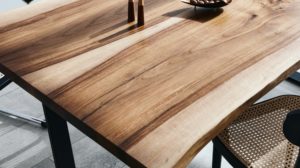We can color the wood using different stains and application methods, achieving the most diverse effects. We have seen herein one of the episodes Finishing Guru, how wood can be evenly stained using fast-drying solvent-based stains. Another range of stains, with other characteristics, helps us to achieve uniform staining on very large surfaces, such as parquet. See the full presentation here.
In the video at the end of this article, made with material provided by Lomilux Cluj, our partner in this project, is presented a series of baths in which the application technique includes erasing. When it is advisable to use this technique, find out below.
The stain brings out the pores and the natural grain of the wood
The stain stain is used to achieve the highlighting of the wood design and a uniform color. It is used on wood with pores, but also on dull wood which, uncoloured, is very uniform, without any elements to personalize it. This is the case withaspen emu, yousome resinous and other species with small pores and hardly noticeable differences between late and early wood. Poplar wood, for example, widely used a few years ago to make old-looking furniture, also called poor art, it is colored yellowish white and the design is almost invisible. Colored with such a wiping bath, the design takes shape, resulting in furniture with a very pleasing appearance.
Also by wiping, color uniformity is achieved. Unlike non-wiping levelling stains, which hide the wood, they do not blur the wood's design. The wiping pushes the stain into the wood evenly, so areas that would normally absorb less stain and remain lighter in color are colored.
Excess material is needed to wipe without the surface drying out during the operation. So apply a larger quantity of material, sufficient for wiping, but not so much that spillage occurs. The beater can be sprayed, applied with a brush, sponge or trowel.
The wiping is first done in circular motions to allow the bath to penetrate well into the pores and the fiber, then, for uniformity, wiping along the fiber. The excess quantity will allow the liquorice to enter the pores and wet them, thus bringing out even more clearly the design formed by them. The wiping also controls the amount of stain that enters the wood, which helps to achieve a uniform color.
BXGLW/XXXX series, water-based indoor water-based baths
Ash wood, a large-pored, light-colored wood, was chosen for the demonstration. The staining was done on ash veneer, but the effect is the same on solid wood. Walnut wood stain was used to contrast as much as possible with the ash wood, so that the final look is walnut-like.
The application was done with a special brush to show that you don't need to spray the bath to achieve the desired effect. Wiping is done immediately after application so as not to give the wood too much time to absorb uncontrolled.
The series is water-based, an important aid in factories that need low-emission products. volatile organic compounds (VOCs) that can be easily used. A water-based stain will, however, raise the wood grain more, and it will be very visible after the first coat of primer.
Sanding between coatsThe sandpapering, done with sandpaper with a grain size of more than 240 in the case of a matt final varnish and more than 400 if it is glossy, will remove these small fibers, which give a rough appearance if not removed. Sanding also removes the small air bubbles in the film which occur particularly in large-pored wood.
Lomilux has a lot of these series, both for interiors, like the one in this presentation, and exteriors. They are differentiated by the way they are applied, the substrate on which they are applied, the resistance of the colorants to direct sunlight, the type of solvent, etc. There are color cards for each of them, and you only need to contact them to find out which is the most suitable stain for the furniture you are producing.
In the video below, you can see how simple it is to apply such a bath and how pleasant the final effect is. If you have any questions about how to apply it or the characteristics of the bathos, leave them below in the dedicated space. I will be sure to reply.




































Thank you for the useful information.